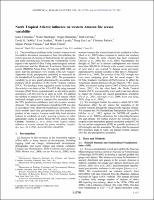Mostrar el registro sencillo del ítem
North Tropical Atlantic influence on western Amazon fire season variability
| dc.contributor.author | Fernandes, K. | |
| dc.contributor.author | Baethgen, W. | |
| dc.contributor.author | Bernardes, S. | |
| dc.contributor.author | Defries, R. | |
| dc.contributor.author | Dewitt, D.G. | |
| dc.contributor.author | Goddard, L. | |
| dc.contributor.author | Lavado-Casimiro, W. | |
| dc.contributor.author | Lee, D.E. | |
| dc.contributor.author | Padoch, C. | |
| dc.contributor.author | Pinedo-Vasquez, M. | |
| dc.contributor.author | Uriarte, M. | |
| dc.date.accessioned | 2019-07-28T16:36:10Z | |
| dc.date.available | 2019-07-28T16:36:10Z | |
| dc.date.issued | 2011-06 | |
| dc.identifier.uri | http://repositorio.senamhi.gob.pe/handle/20.500.12542/100 | |
| dc.description.abstract | The prevailing wet climate in the western Amazon is not favorable to the natural occurrence of fires. Nevertheless, the current process of clearing of humid forests for agriculture and cattle ranching has increased the vulnerability of the region to the spread of fires. Using meteorological stations precipitation and the Moderate Resolution Spectroradiometer (MODIS) Active-Fires (AF) during 2000-2009, we show that fire anomalies vary closely with July-August-September (JAS) precipitation variability as measured by the Standardized Precipitation Index (SPI). The precipitation variability is, in turn, greatly determined by sea surface temperature (SST) anomalies in the North Tropical Atlantic (NTA). We develop a linear regression model to relate local fire activity to an index of the NTA-SST. By using seasonal forecasts of SST from a coupled model, we are able to predict anomalous JAS fire activity as early as April. We applied the method to predict the severe 2010 JAS season, which indicated strongly positive seasonal fire anomalies within the 95% prediction confidence intervals in most western Amazon. The spatial distribution of predicted SPI was also in accordance with observed precipitation anomalies. This three months lead time precipitation and fire prediction product in the western Amazon could help local decision makers to establish an early warning systems or other appropriate course of action before the fire season begins. | en_US |
| dc.format | application/pdf | |
| dc.language.iso | eng | en_US |
| dc.publisher | Blackwell Publishing Ltd | en_US |
| dc.relation.ispartof | urn:issn:0094-8276 | |
| dc.rights | info:eu-repo/semantics/openAccess | es_PE |
| dc.rights | Attribution-NonCommercial-ShareAlike 3.0 United States | * |
| dc.rights.uri | http://creativecommons.org/licenses/by-nc-sa/3.0/us/ | * |
| dc.source | Servicio Nacional de Meteorología e Hidrología del Perú | es_PE |
| dc.source | Repositorio Institucional - SENAMHI | es_PE |
| dc.subject | Atmospheric temperature | en_US |
| dc.subject | Financial data processing | en_US |
| dc.subject | Forecasting | en_US |
| dc.subject | Linear regression | en_US |
| dc.subject | Precipitation (meteorology) | en_US |
| dc.subject | Radiometers | en_US |
| dc.title | North Tropical Atlantic influence on western Amazon fire season variability | en_US |
| dc.type | info:eu-repo/semantics/article | en_US |
| dc.identifier.isni | 0000 0001 0746 0446 | |
| dc.description.peerreview | Por pares | |
| dc.identifier.doi | https://doi.org/10.1029/2011GL047392 | |
| dc.source.volume | 38 | es_PE |
| dc.source.issue | 11 | es_PE |
| dc.source.journal | Geophysical Research Letters | es_PE |
| dc.subject.sinia | temperatura - Aire y Atmósfera | |
| dc.type.sinia | text/publicacion cientifica | |
| dc.identifier.url | https://hdl.handle.net/20.500.12542/100 |
Ficheros en el ítem
Este ítem aparece en la(s) siguiente(s) colección(es)
-
Artículo científico [171]









